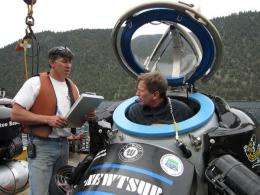Discoveries in the Deep

Scientists from NASA and the Canadian Space Agency have been using Pavilion Lake as a testing ground for the future human exploration of other worlds.
Pavilion Lake, in British Columbia, Canada, is home to a biological mystery. Microbialites, coral-like structures built by bacteria, in a variety of sizes and shapes, carpet the lakebed. That’s unusual for a freshwater lake like Pavilion. So unusual that researchers don’t know of any other freshwater lake in the world that has microbialites with some of the same strange shapes.
That explains why scientists have established the Pavilion Lake Research Project (PLRP) to study the lake. They want to understand what’s so unusual about seemingly normal Pavilion Lake, how the microbial structures manage to survive, why they aren’t destroyed by snails, worms and other grazing animals, as they are elsewhere.
What it doesn’t explain is why NASA’s MMAMA (Moon and Mars Analogue Missions Activities) program has funded the PRLP to continue its work for the next several years. Or why astronauts from NASA and CSA (the Canadian Space Agency) are participating in the project. After all, there are no lakes on the moon, and it’s been a long time since there were any on Mars.
Because of the logistical difficulty of doing comprehensive exploration in an underwater environment, however, lessons learned in the process of exploring Pavilion Lake are directly relevant to future human exploration of other worlds.
“We’re doing science in a setting where we have limited life support,” says Darlene Lim of NASA Ames Research Center, PLRP’s principal investigator. “I can’t just walk out and hang out with [an interesting] rock all day.”
PLRP divers have been studying the lake for several years, but were able to survey only a small fraction of it. So in 2008, researchers began exploring in the lake in DeepWorkers, mini-submersibles just large enough for a pilot to squeeze inside. That’s when NASA and CSA sent astronauts to the scene. A second round of DeepWorker exploration took place in 2009.
While conducting scientific research, Lim and the other DeepWorker pilots must constantly monitor their oxygen supply and battery power, and check to make sure no system faults are occurring. In this way, their experience resembles the challenges astronauts will face exploring the surface of another world.
Of particular interest to NASA and the CSA are questions about how researchers can maximize their scientific return, given the limited amount of time pilots can spend in the DeepWorkers. That has meant teaching pilots - including astronauts with limited scientific field experience - how to perform good scientific observations while contending with the stress of operating underwater.
“We wanted to make sure that we discussed how to balance being execution-minded and discovery-minded,” Lim explained. “Execution-mindedness is where you’re very good at following a sequence of steps. That’s great,” she conceded, but “you might [fly right] by something that was incredibly important.” Knowing when to stop, when to interrupt the plan, when to turn around and go back for a second look, is a skill that is best learned and honed in a real field science setting. It would be “a real shame to send somebody all the way to Mars and have them miss the alien, right?”
To that end, PLRP experimented with both new technology and new procedures during the 2009 field season.
For example, pilots both last year and this year captured continuous steams of video during their underwater flights. But this year the video was captured to hard disk, rather than to tape.
That technological leap, in turn, made possible a procedural leap. Each night the entire team was able to review the day’s work, by discussing the science data, evaluating pilots’ activity and suggesting improvements, which could be implemented literally overnight. “Within a flight - not three flights, but within a flight - we saw dramatic improvement in everybody’s capabilities as pilots and as observational scientists,” said Lim.
“It reminded me of a ballet class where the teacher shows you how to do something, then you’re supposed to do it. And then they’ll come around and correct you. But the rest of the time, you’re kind of watching each other in the mirror. And that’s exactly what this was. It was an opportunity to watch each other in the mirror. And watch yourself in the mirror. And adjust.”
PLRP this year also worked with software engineers from the Intelligent Robotics Group (IRG) at NASA Ames to generate data-rich maps of the lake, updated in real time. IRG engineers onboard “chase” boats on the surface followed the subs as they explored underwater, populating their map with points of interest, represented by icons. Clicking an icon opened a window that contained video or field notes associated with a particular spot in the lake.
Research at Pavilion Lake will continue with one more field season in the summer of 2010. After that, PLRP will most likely move on to explore other lakes. “The real test” of “all those protocols,” Lim said, is “if you can take them somewhere else and they work” there, too.
Source: Astrobio.net, by Henry Bortman














